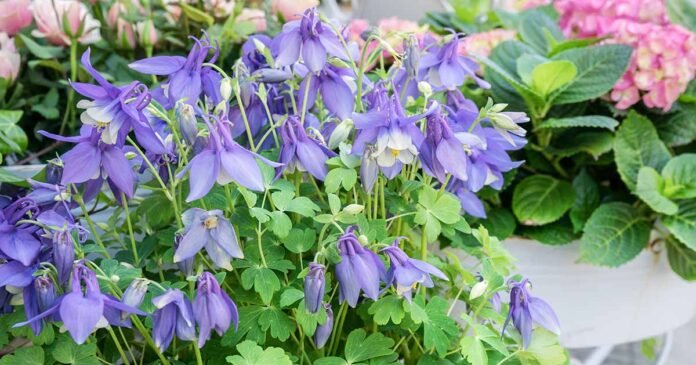4. Common Hepatica
The common hepatica (Hepatica americana) is known by various names, including blue anemone, liverleaf, and mayflower. This species is native to the southeastern US.

It’s a charming wildflower that grows close to the ground in woodsy settings, where there is partial shade and rich, well-drained soil.
As an herbaceous plant, the stems, leaves, and flowers die at the end of the growing season while roots lie dormant beneath the soil throughout the winter.
This species grows up to six inches tall and blooms in early spring. Depending on the variety the flowers may be blue, pink, or white and are sometimes fragrant.
Hardy in Zones 3 to 8, common hepatica enjoys a part shade location and organically-rich, well draining soil.
5. Colorado Blue Columbine
Colorado blue columbine (Aquilegia caerulea) is native to the Colorado Rocky Mountain region that thrives in moist, well-drained soil.


This hardy herbaceous perennial does best in full sun but will tolerate partial shade. It is the Colorado state flower, and a protected species.
Colorado blue columbine may succumb to the heat of areas with hot summers after just a few years, usually because the soil isn’t moist enough.
However, it self-propagates by scattering seeds that grow into new plants, much like an annual.
Plants grow two to three feet tall and bloom in late spring. The blooms consist of central white petals flanked with blue sepals, providing a delightful, star-like display. Hardy in Zones 3 to 8.
You can find seeds in packets of 60 available at Burpee.
6. False Indigo
False indigo (Baptisia australis) is a large, clumping perennial, native to the eastern US, that looks great at the back of a border.


It has small violet-blue blossoms in clusters called racemes, which are elongated like that of the larkspur or delphinium.
It is a majestic wildflower growing two to four feet tall with deep roots that shares space companionably with neighboring plants.
Grow in full sun to part shade in average, well-draining soil. Hardy in Zones 3 to 10.
Give it time to establish, and you’ll have a stunning landscape scheme. Divide roots during dormant periods to thin plants.
Note: All parts of this plant are toxic.
You can find false indigo plants available in #1 containers at Nature Hills Nursery.
Our guide to growing false indigo has more information.
7. Great Blue Lobelia
Great blue lobelia (Lobelia siphilitica) is an herbaceous perennial native to eastern and central US.


It blooms from mid to late summer in Zones 4 to 9 with spikes of vivid blue, tubular blooms.
Plants reach two to four feet tall and thrive in organically-rich, fertile soil that is consistently moist.
A full sun location is ideal but this species will tolerate part shade, especially in hot climates.
8. Lewis Flax
Lewis or blue flax (Linum lewisii) is a short-lived perennial native to much of western North America, from Alaska and western Canada down through the western United States into northern Mexico.


Its delicate, sky-blue flowers open in the morning and often drop by afternoon, with new blooms appearing daily from late spring into midsummer.



